Double-Layer Coils Design for 11 kW Wireless Power Transfer
Abstract
1. Introduction
2. System Description, Modeling, and Theoretical Background
2.1. Parameter Determination for the Equivalent Circuit with LCC and S Compensation Topology
3. Numerical Simulation Results
3.1. Effect of the Arrangement and Number of Ferrite Tiles
3.2. Misalignment Simulation Results for the Chosen Optimal Model
4. Measurements
4.1. Physical Prototype Description
4.2. Experimental Verification
4.3. Experimental WPT System
4.4. Future Work
5. Conclusions
Author Contributions
Funding
Data Availability Statement
Acknowledgments
Conflicts of Interest
References
- Bosshard, R.; Kolar, J.W. Multi-Objective Optimization of 50 kW/85 kHz IPT System for Public Transport. IEEE J. Emerg. Sel. Top. Power Electron. 2016, 4, 1370–1382. [Google Scholar] [CrossRef]
- Ahmad, A.; Alam, M.S.; Chabaan, R. A comprehensive review of wireless charging technologies for electric vehicles. IEEE Trans. Transp. Electrif. 2018, 4, 38–63. [Google Scholar] [CrossRef]
- Dai, J.; Ludois, D.C. A Survey of Wireless Power Transfer and a Critical Comparison of Inductive and Capacitive Coupling for Small Gap Applications. IEEE Trans. Power Electron. 2015, 30, 6017–6029. [Google Scholar] [CrossRef]
- Sasaki, S.; Tanaka, K.; Maki, K. Microwave Power Transmission Technologies for Solar Power Satellites. Proc. IEEE 2013, 101, 1438–1447. [Google Scholar] [CrossRef]
- Mayordomo, I.; Dräger, T.; Spies, P.; Bernhard, J.; Pflaum, A. An Overview of Technical Challenges and Advances of Inductive Wireless Power Transmission. Proc. IEEE 2013, 101, 1302–1311. [Google Scholar] [CrossRef]
- Park, Y.-J. Next-generation wireless charging systems for mobile devices. Energies 2022, 15, 3119. [Google Scholar] [CrossRef]
- Van, S.D.; Ngo, H.Q.; Cotton, S.L. Wireless powered wearables using distributed massive mimo. IEEE Trans. Commun. 2020, 68, 2156–2172. [Google Scholar] [CrossRef]
- Campi, T.; Cruciani, S.; Palandrani, F.; De Santis, V.; Hirata, A.; Feliziani, M. Wireless Power Transfer charging system for AIMDs and pacemakers. IEEE Trans. Microw. Theory Technol. 2016, 64, 633–642. [Google Scholar] [CrossRef]
- Wang, G.; Liu, W.; Sivaprakasam, M.; Kendir, G.A. Design and analysis of an adaptive transcutaneous power telemetry for biomedical implants. IEEE Trans. Circuits Syst. I Regul. Pap. 2005, 52, 2109–2117. [Google Scholar] [CrossRef]
- Fadhel, Y.B.; Bouattour, G.; Bouchaala, D.; Derbel, N.; Kanoun, O. Model-Based Optimization of Spiral Coils for Improving Wireless Power Transfer. Energies 2023, 16, 6886. [Google Scholar] [CrossRef]
- Sezer, C.; Altintas, N. Adaptation of Inductive Power Transfer to Small Household Appliances That Can Operate on Induction Heating Cooktops: Wireless Electric Kettle. Energies 2023, 16, 3544. [Google Scholar] [CrossRef]
- Aziz, A.F.A.; Romlie, M.F.; Baharudin, Z. Review of inductively coupled power transfer for electric vehicle charging. IET Power Electron. 2019, 12, 3611–3623. [Google Scholar] [CrossRef]
- Trivino, A.; Gonzalez-Gonzalez, J.M.; Aguado, J.A. Wireless power transfer technologies applied to electric vehicles: A review. Energies 2021, 14, 1547. [Google Scholar] [CrossRef]
- Mohamed, A.A.S.; Shaier, A.A.; Metwally, H.; Selem, S.I. An overview of dynamic inductive charging for electric vehicles. Energies 2022, 15, 5613. [Google Scholar] [CrossRef]
- Chittoor, P.K.; Chokkalingam, B.; Mihet-Popa, L. A review on UAV wireless charging: Fundamentals, applications, charging techniques and standards. IEEE Access 2021, 9, 69235–69266. [Google Scholar] [CrossRef]
- Kim, J.; Kim, K.; Kim, H.; Kim, D.; Park, J.; Ahn, S. An efficient modeling for underwater wireless power transfer using z-parameters. IEEE Trans. Electromagn. Compat. 2019, 61, 2006–2014. [Google Scholar] [CrossRef]
- Campi, T.; Cruciani, S.; Feliziani, M. Wireless Power Transfer Technology Applied to an Autonomous Electric UAV with a Small Secondary Coil. Energies 2018, 11, 352. [Google Scholar] [CrossRef]
- Zhang, S.; Yu, J.J.Q. Electric vehicle dynamic wireless charging system: Optimal placement and vehicle-to-grid scheduling. IEEE Internet Things J. 2022, 9, 6047–6057. [Google Scholar] [CrossRef]
- SAE J2954; Wireless Power Transfer for Light-Duty Plug-In/Electric Vehicles and Alignment Methodology. SAE International: Pittsburgh, PA, USA, 2019.
- SAE J2954/2; Wireless Power Transfer for Heavy-Duty Electric Vehicles. SAE International: Pittsburgh, PA, USA, 2022.
- IEC 61980; Electric Vehicle Wireless Power Transfer (wpt) Systems—Part 1: General Requirements. International Electrotechnical Commission: Geneva, Switzerland, 2016.
- Sulejmani, E.; Beltle, M.; Tenbohlen, S. EMC of Inductive Automotive Charging Systems According to Standard SAE J2954. Vehicles 2023, 5, 1532–1552. [Google Scholar] [CrossRef]
- Feng, H.; Tavakoli, R.; Onar, O.C.; Pantic, Z. Advances in High-Power Wireless Charging Systems: Overview and Design Considerations. IEEE Trans. Transp. Electrif. 2020, 6, 886–919. [Google Scholar] [CrossRef]
- Patil, D.; McDonough, M.K.; Miller, J.M.; Fahimi, B.; Balsara, P.T. Wireless Power Transfer for Vehicular Applications: Overview and Challenges. IEEE Trans. Transp. Electrif. 2018, 4, 3–37. [Google Scholar] [CrossRef]
- Bandyopadhyay, S.; Venugopal, P.; Dong, J.; Bauer, P. Comparison of Magnetic Couplers for IPT Based EV Charging Using Multi-Objective Optimization. IEEE Trans. Veh. Technol. 2019, 68, 5416–5429. [Google Scholar] [CrossRef]
- Liu, N.; Habetler, T.G. Design of a Universal Inductive Charger for Multiple Electric Vehicle Models. IEEE Trans. Power Electron. 2015, 30, 6378–6390. [Google Scholar] [CrossRef]
- Bosshard, R.; Mühlethaler, J.; Kolar, J.W.; Stevanović, I. Optimized magnetic design for inductive power transfer coils. In Proceedings of the 2013 Twenty-Eighth Annual IEEE Applied Power Electronics Conference and Exposition (APEC), Long Beach, CA, USA, 17–21 March 2013; pp. 1812–1819. [Google Scholar] [CrossRef]
- Khalid, H.; Mekhilef, S.; Mubin, M.; Seyedmahmoudian, M. Advancements in inductive power transfer: Overcoming challenges and enhancements for static and dynamic electric vehicle applications. Energy Rep. 2023, 10, 3427–3452. [Google Scholar] [CrossRef]
- Elnail, K.E.I.; Huang, X.; Xiao, C.; Tan, L.; Haozhe, X. Core Structure and Electromagnetic Field Evaluation in WPT Systems for Charging Electric Vehicles. Energies 2018, 11, 1734. [Google Scholar] [CrossRef]
- Zaheer, A.; Kacprzak, D.; Covic, G.A. A bipolar receiver pad in a lumped IPT system for electric vehicle charging applications. In Proceedings of the 2012 IEEE Energy Conversion Congress and Exposition (ECCE), Raleigh, NC, USA, 15–20 September 2012; p. 283. [Google Scholar] [CrossRef]
- Thein, M.E.; Charoensuk, J.; Masomtob, M.; Onreabroy, W.; Kaewpradap, A. Investigation of power transfer efficiency: Utilizing different coil designs in wireless charging of electric vehicles. In Proceedings of the 11th TSME-International Conference on Mechanical Engineering (TSME-ICoME 2020), Ubon Ratchathani, Thailand, 1–4 December 2020. [Google Scholar] [CrossRef]
- Yang, Y.; Cui, J.; Cui, X. Design and Analysis of Magnetic Coils for Optimizing the Coupling Coefficient in an Electric Vehicle Wireless Power Transfer System. Energies 2020, 13, 4143. [Google Scholar] [CrossRef]
- González-González, J.M.; Triviño-Cabrera, A.; Aguado, J.A. Assessment of the Power Losses in a SAE J2954—Compliant Wireless Charger. IEEE Access 2022, 10, 54474–54483. [Google Scholar] [CrossRef]
- Song, K.; Lan, Y.; Zhang, X.; Jiang, J.; Sun, C.; Yang, G.; Yang, F.; Lan, H. A Review on Interoperability of Wireless Charging Systems for Electric Vehicles. Energies 2023, 16, 1653. [Google Scholar] [CrossRef]
- Okasili, I.; Elkhateb, A.; Littler, T. A Review of Wireless Power Transfer Systems for Electric Vehicle Battery Charging with a Focus on Inductive Coupling. Electronics 2022, 11, 1355. [Google Scholar] [CrossRef]
- Despotović, Ž.; Reljić, D.; Vasić, V.; Oros, D. Steady-state multiple parameters estimation of the inductive power transfer system. IEEE Access 2022, 10, 46878–46894. [Google Scholar] [CrossRef]
- Ali, E.M.; Alibakhshikenari, M.; Virdee, B.S.; Soruri, M.; Limiti, E. Efficient Wireless Power Transfer via Magnetic Resonance Coupling Using Automated Impedance Matching Circuit. Electronics 2021, 10, 2779. [Google Scholar] [CrossRef]
- Li, W.; Zhao, H.; Deng, J.; Li, S.; Mi, C.C. Comparison Study on SS and Double-Sided LCC Compensation Topologies for EV/PHEV Wireless Chargers. IEEE Trans. Veh. Technol. 2016, 65, 4429–4439. [Google Scholar] [CrossRef]
- Chen, Y.; Zhang, H.; Shin, C.S.; Seo, K.H.; Park, S.J.; Kim, D.H. A Comparative Study of S-S and LCC-S Compensation Topology of Inductive Power Transfer Systems for EV Chargers. In Proceedings of the 2019 IEEE 10th International Symposium on Power Electronics for Distributed Generation Systems (PEDG), Xi’an, China, 3–6 June 2019. [Google Scholar] [CrossRef]
- Li, Y.; Zhu, Y.; Liu, W.; Zhu, Y.; Pei, Y.; Wen, H.; Zhao, C. High Efficiency WPT System for Electric Vehicles with LCL-S and SS compensation. In Proceedings of the IEEE 4th International Future Energy Electronics Conference (IFEEC), Singapore, 25–28 November 2019. [Google Scholar] [CrossRef]
- Zhu, Y.; Wu, H.; Li, F.; Zhu, Y.; Pei, Y.; Liu, W. A Comparative Analysis of S-S and LCCL-S Compensation for Wireless Power Transfer with a Wide Range Load Variation. Electronics 2022, 11, 420. [Google Scholar] [CrossRef]
- Chen, Y.; Zhang, H.; Park, S.J.; Kim, D.H. A Switching Hybrid LCC-S Compensation Topology for Constant Current/Voltage EV Wireless Charging. IEEE Access 2019, 7, 133924–133935. [Google Scholar] [CrossRef]
- Herceg, D.; Juhas, A.; Milutinov, M. A Design of a Four Square Coil System for a Biomagnetic Experiment. Facta Univ. Ser. Electron. Energ. 2009, 22, 285–292. [Google Scholar] [CrossRef]
- COMSOL Multiphysics Software. Available online: http://www.comsol.com (accessed on 2 November 2023).
- Popović, B. Elektromagnetika, 6th ed.; IP Nauka: Belgrade, Serbia, 2001; pp. 233–272. [Google Scholar]
- Hioki—LCR Meters, Impedance Analyzers, Capacitance Meters. Available online: https://www.hioki.com/ (accessed on 5 November 2023).

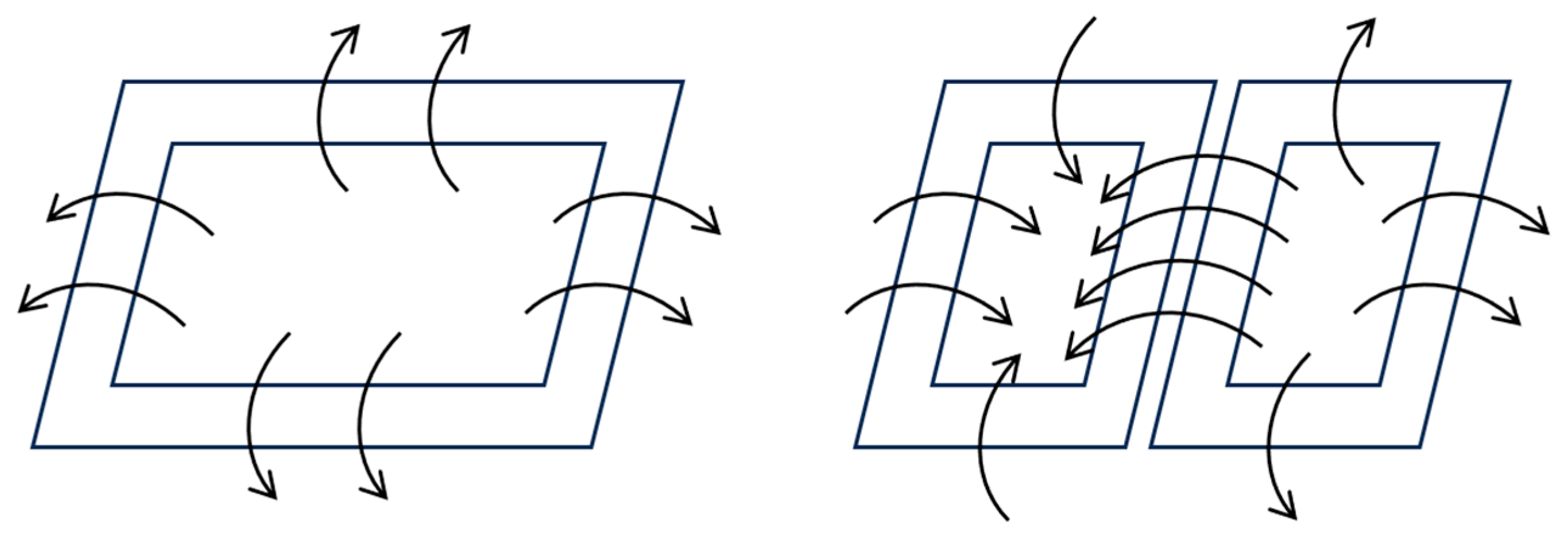



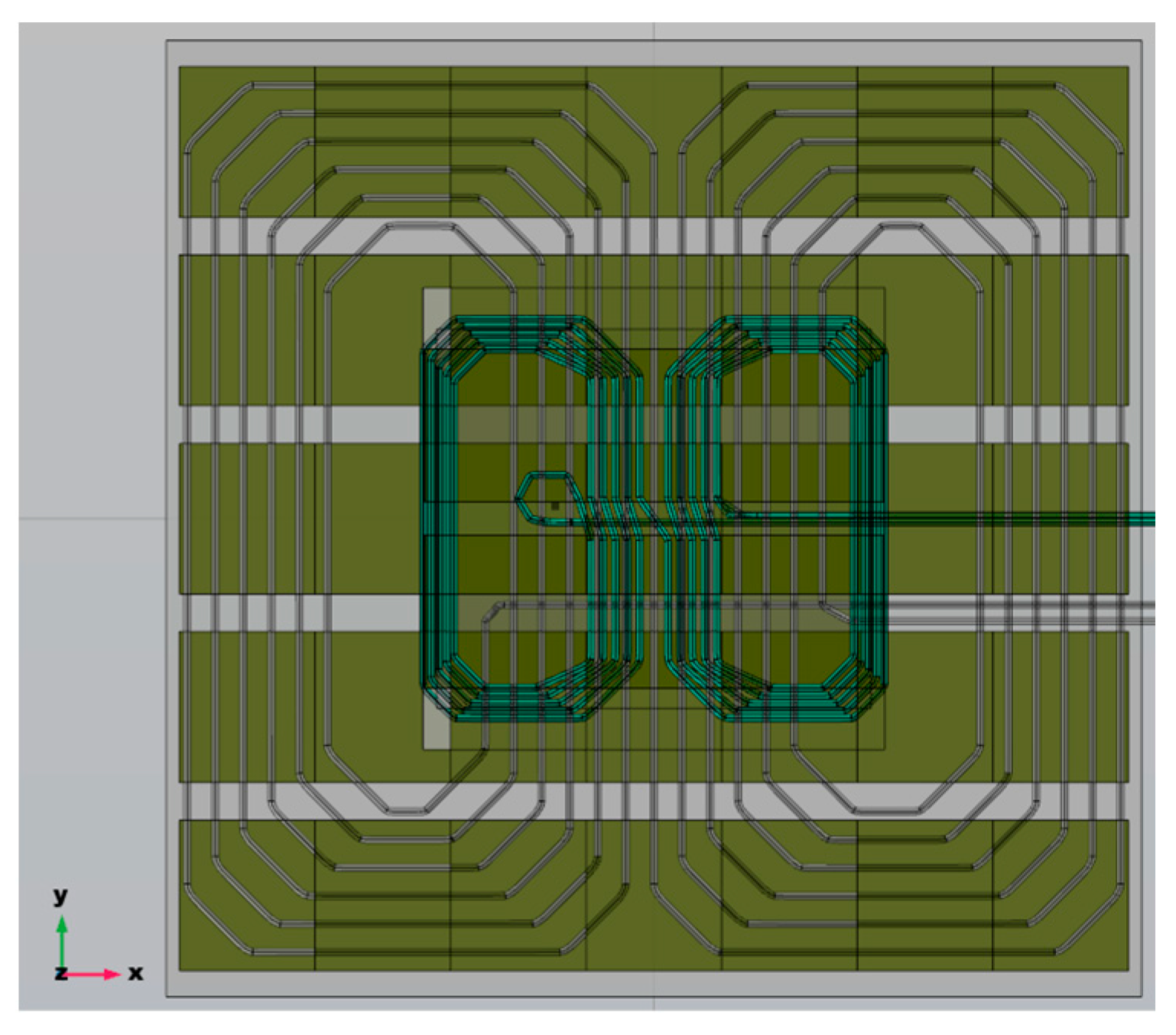



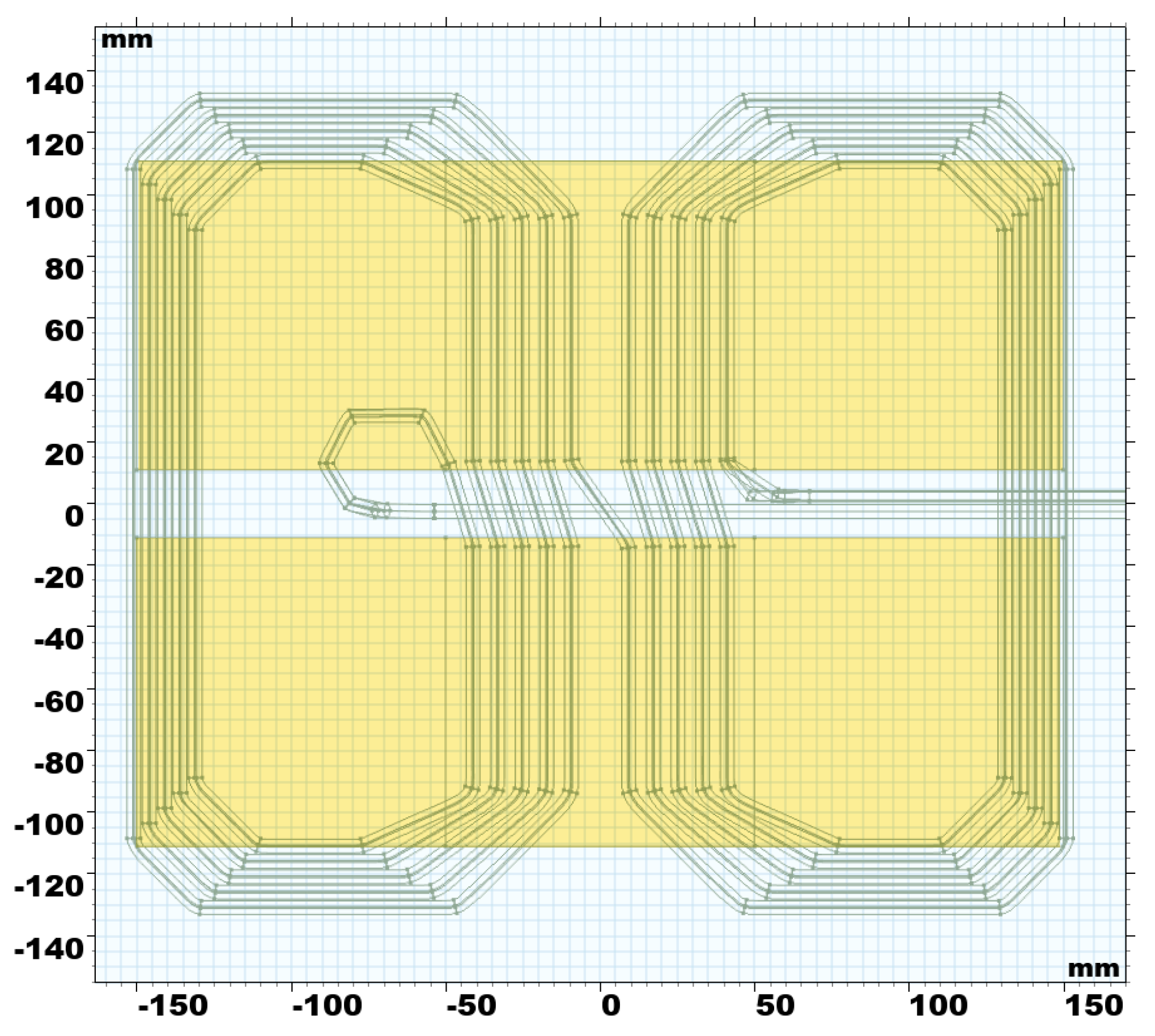
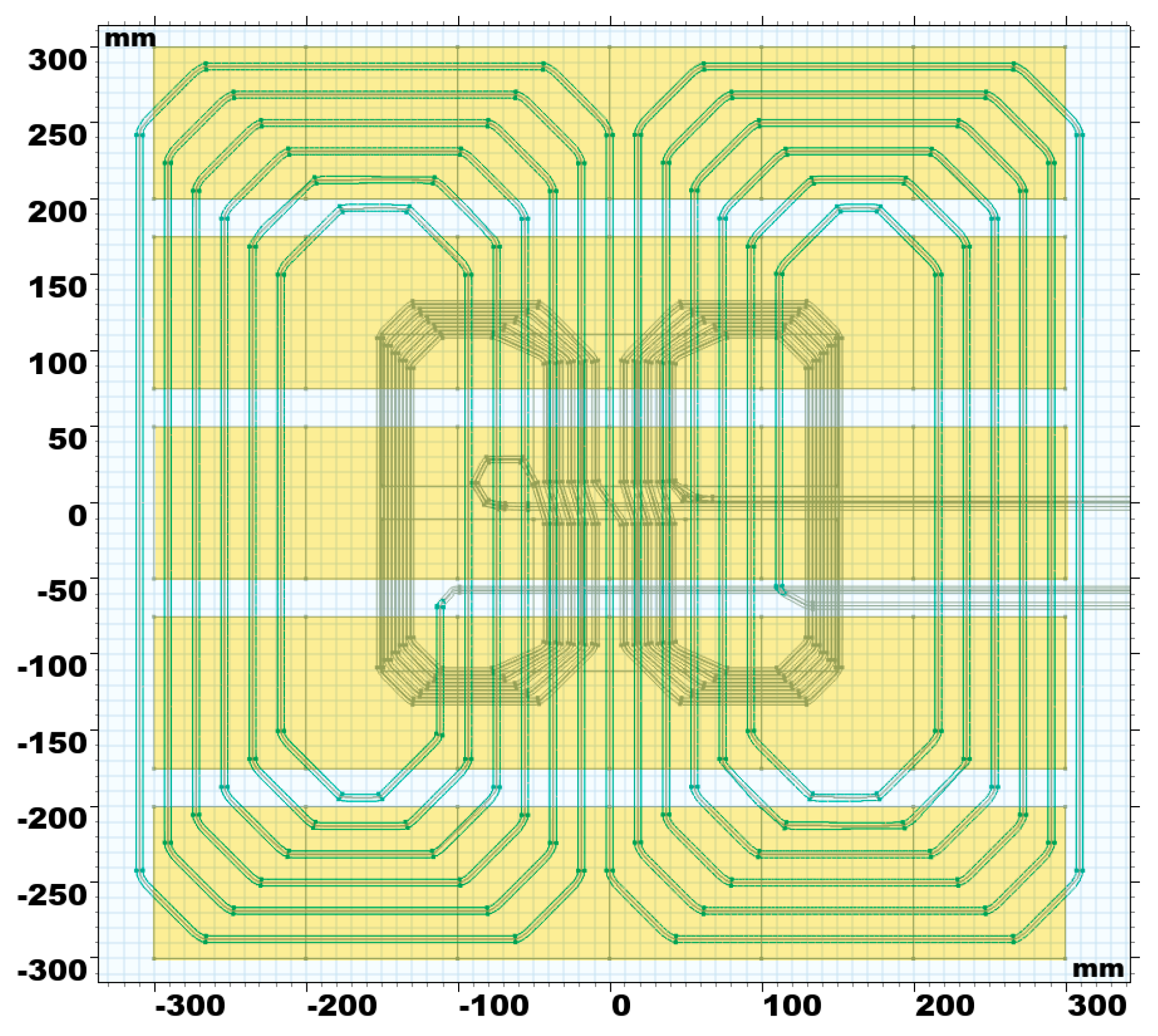
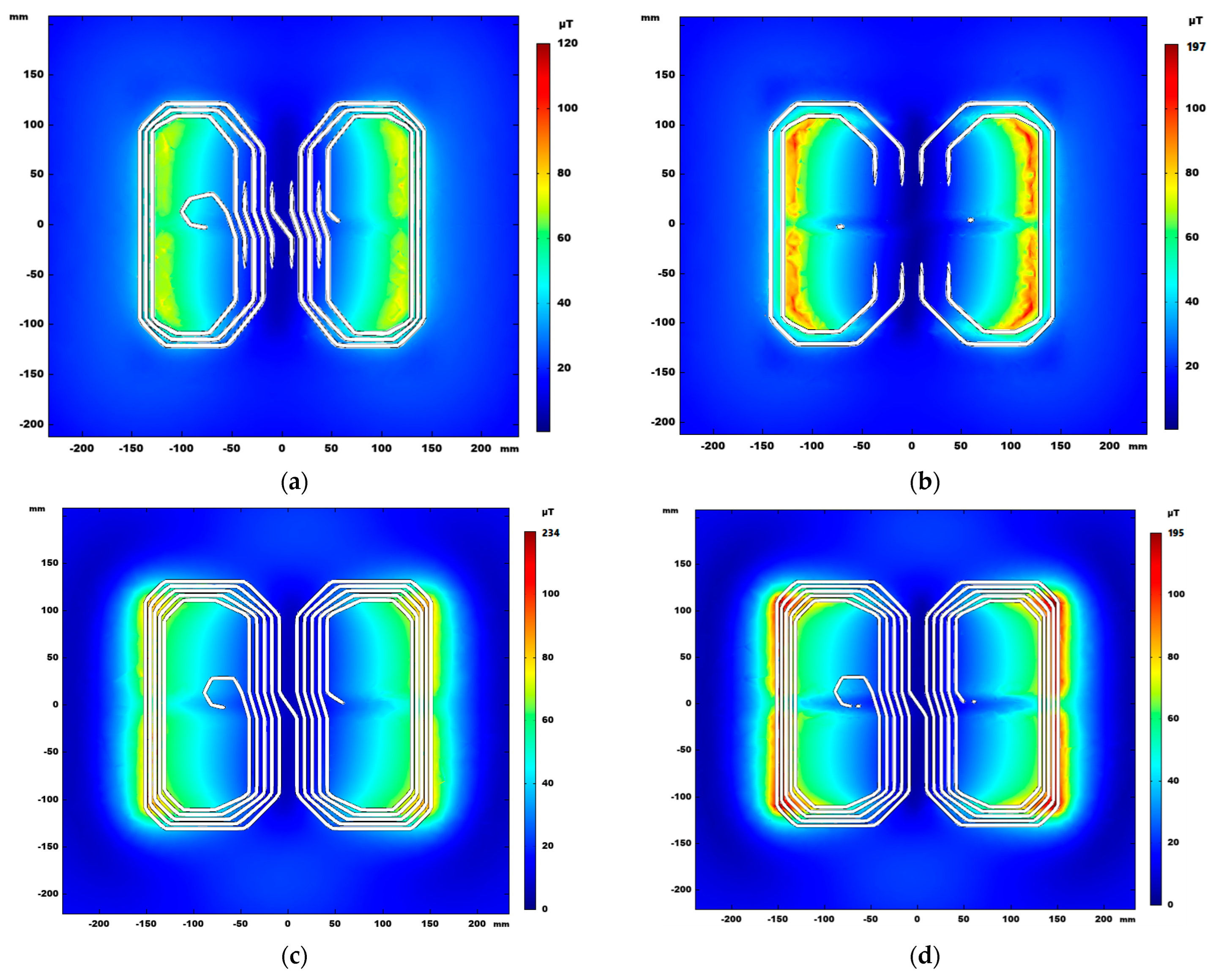
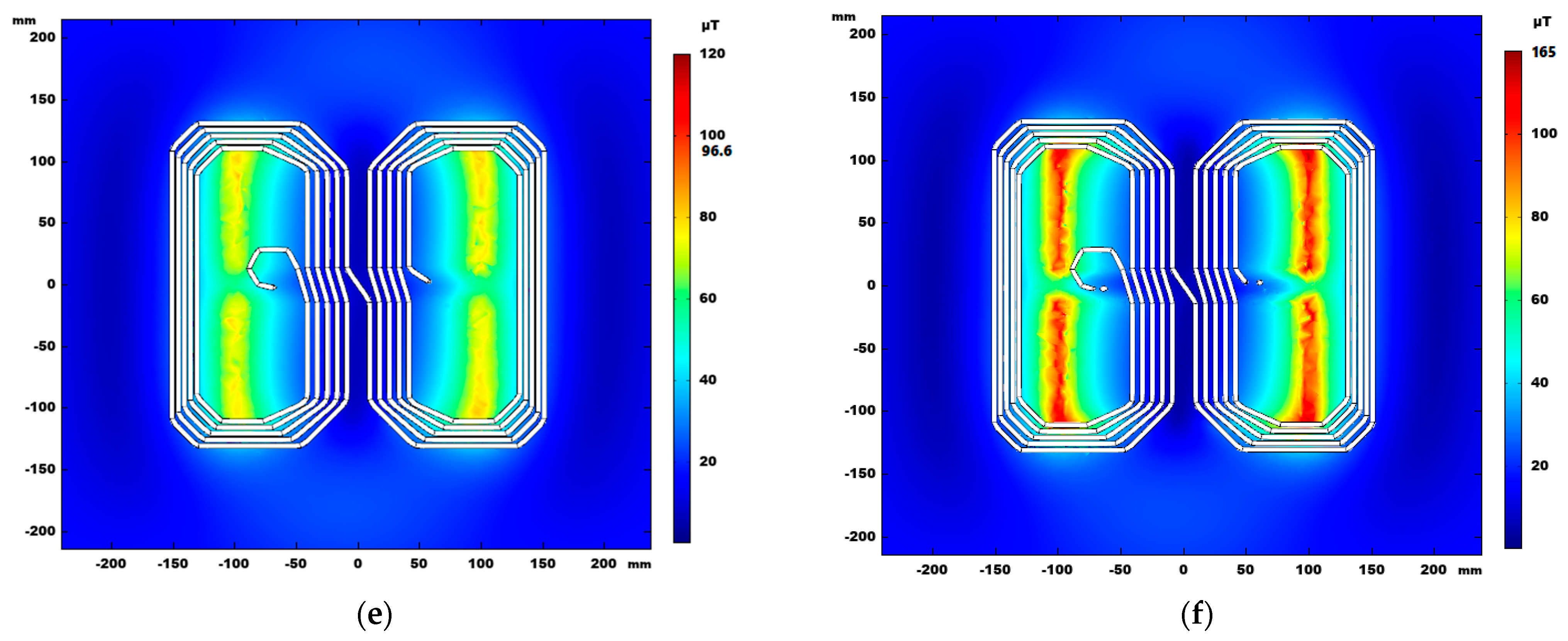
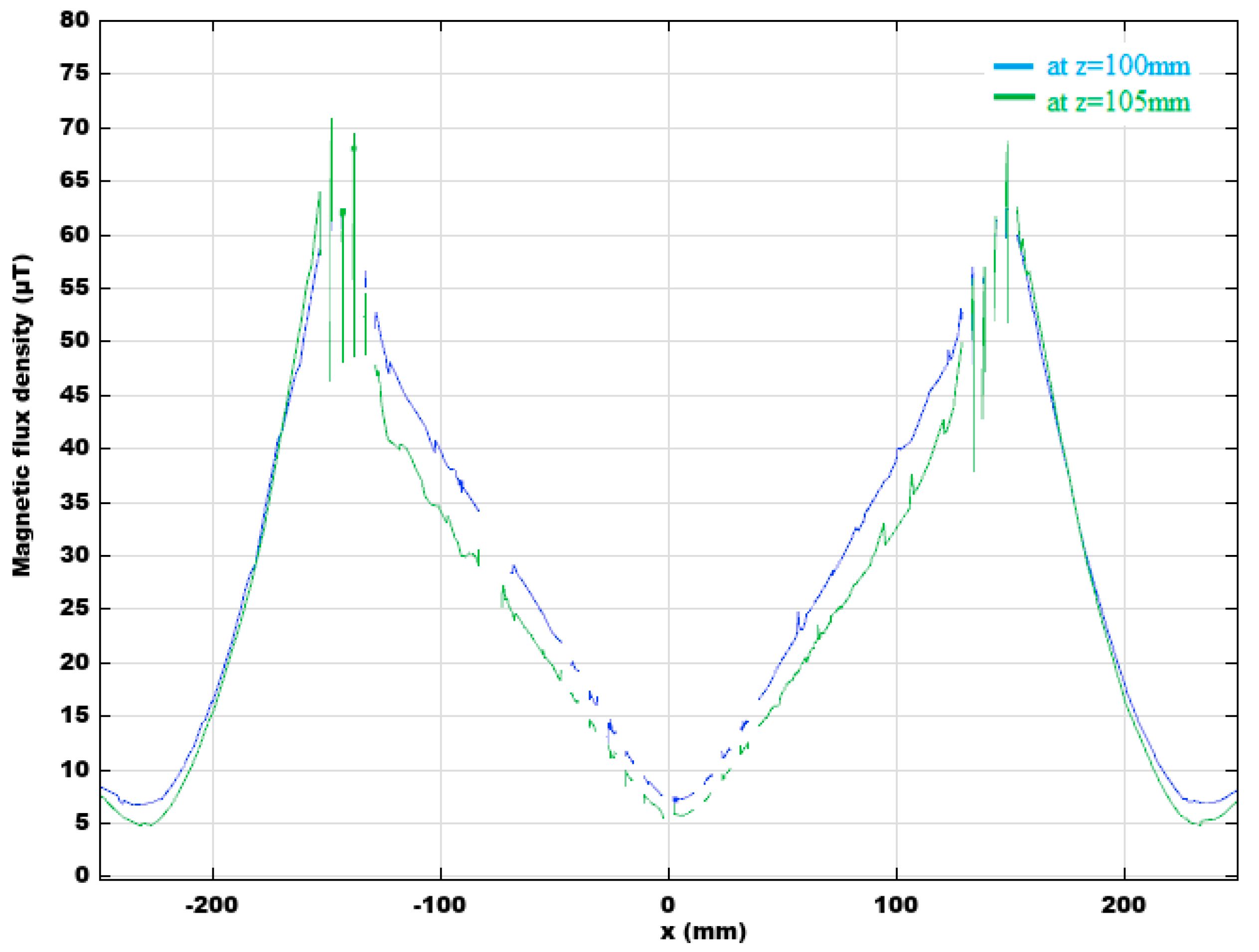

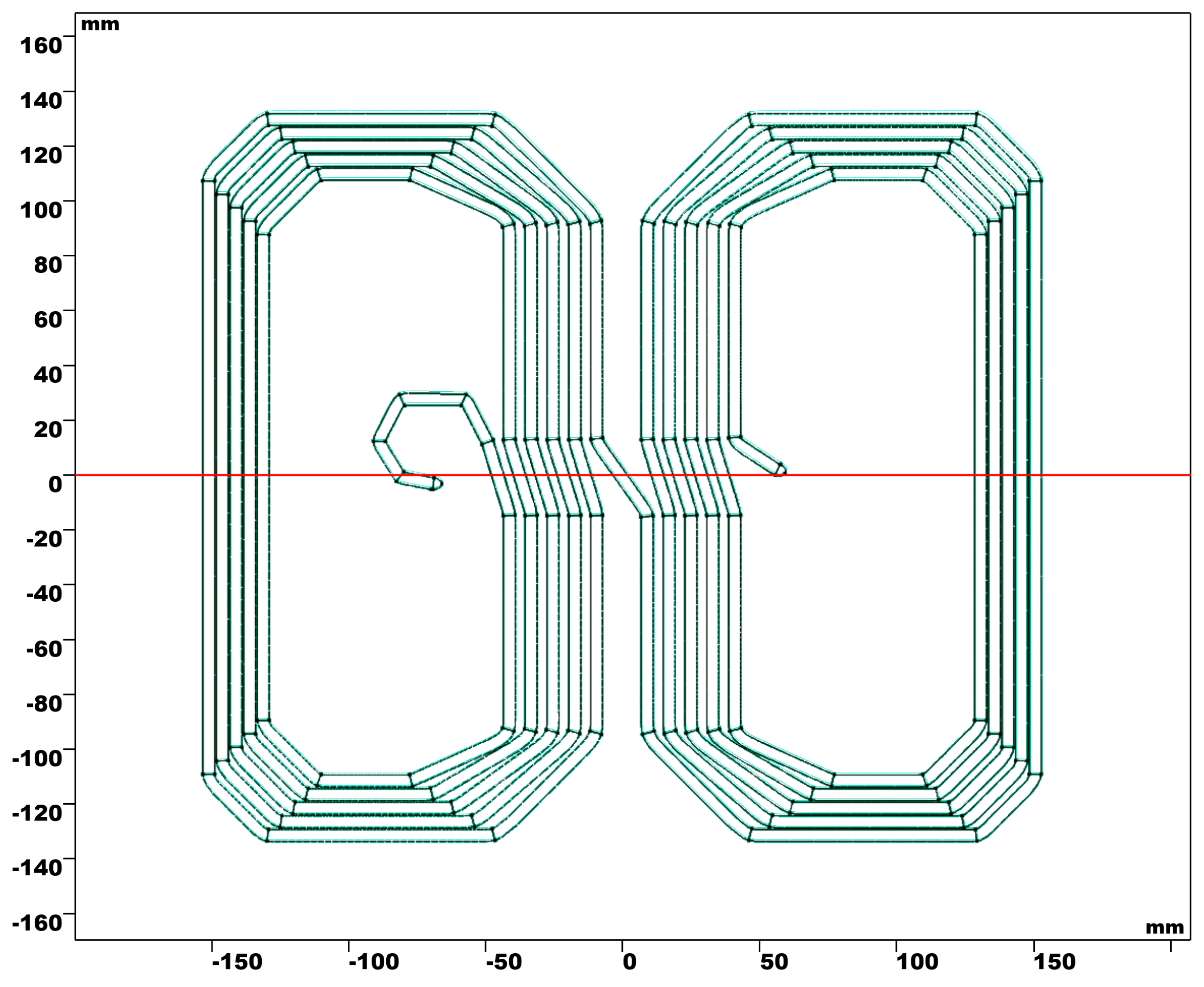

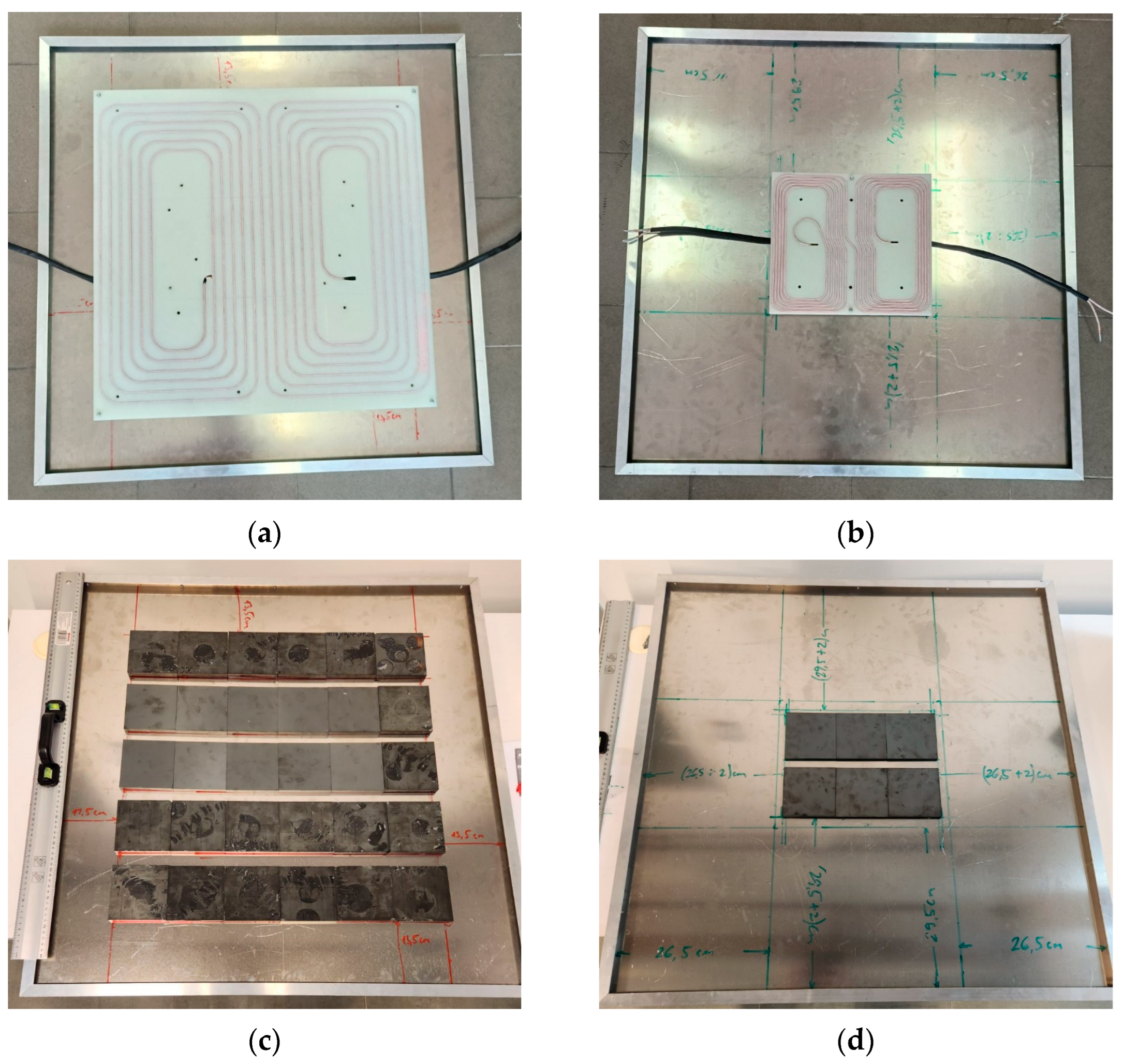


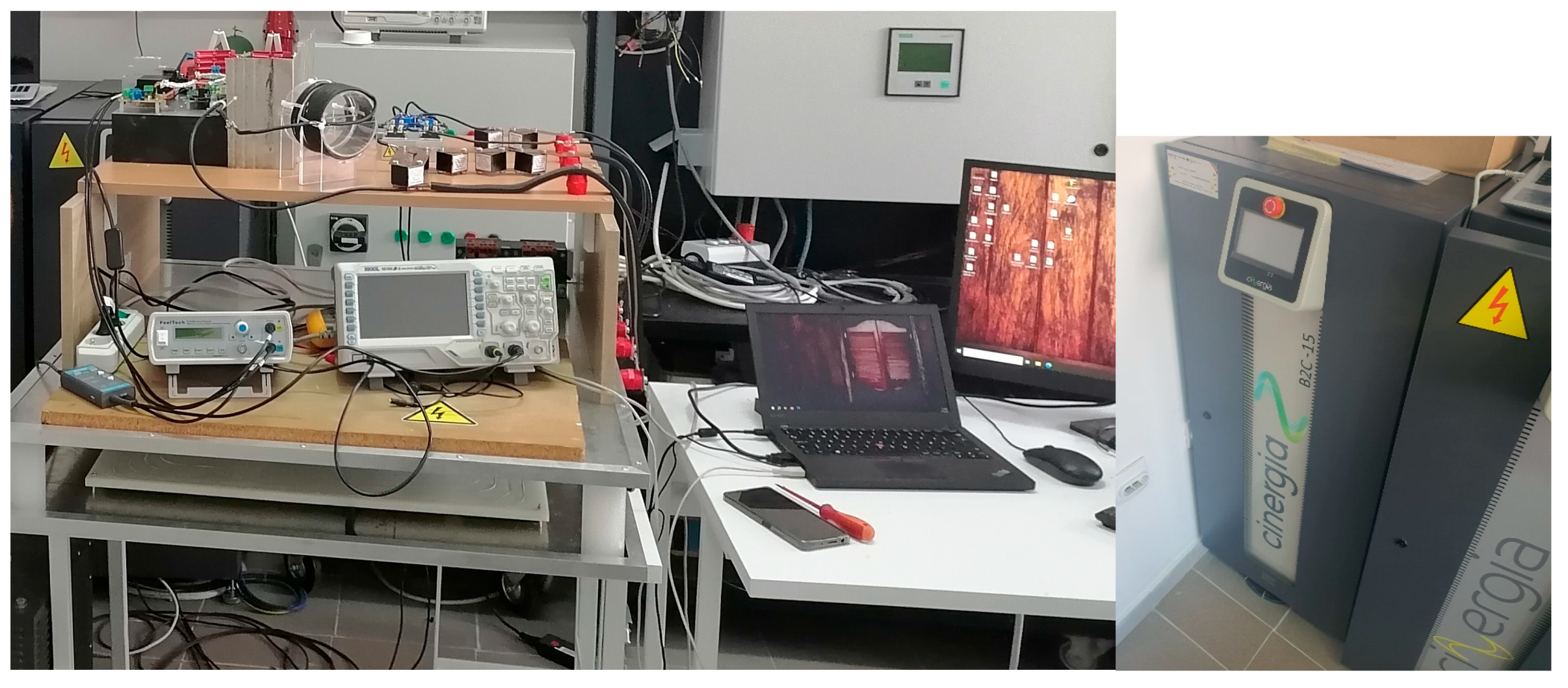
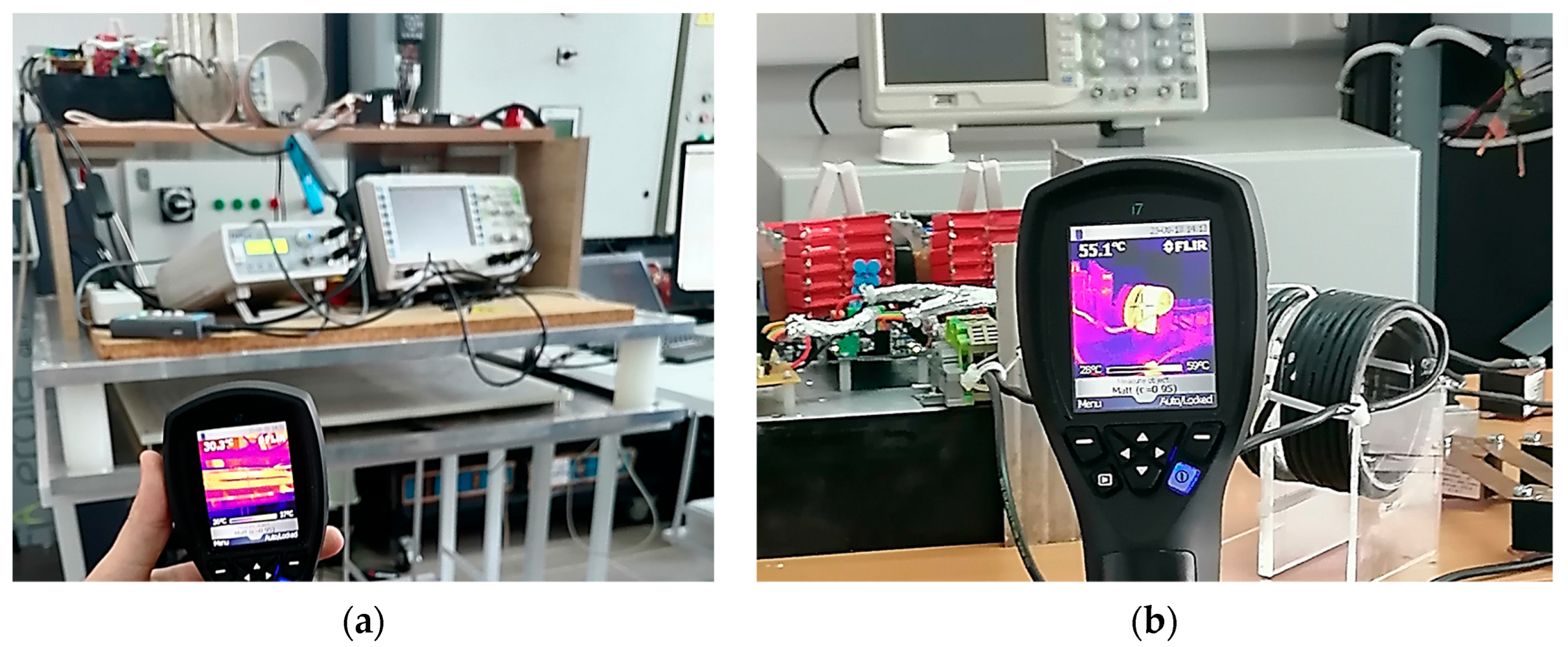
| LD Vehicles SAE J2954—2019 | HD Vehicles SAE J2954/2—2022 | ||
|---|---|---|---|
| Maximum power level | WPT-1; 3.7 kVA | Maximum power level | HD-WPT4; 20 kW |
| WPT-2; 7.7 kVA | HD-WPT5; 50 kW | ||
| WPT-3; 11.1 kVA | HD-WPT6; 75 kW | ||
| WPT-4; 22 kVA | HD-WPT7; 150 kW | ||
| HD-WPT8; 250 kW | |||
| HD-WPT9; 500 kW | |||
| Class level for VA coil ground clearance range | Z1; 100–150 mm | Class level for VA coil ground clearance range | HD Z1; 100–150 mm |
| Z2; 140–210 mm | HD Z2; 150–200 mm | ||
| Z3; 170–250 mm | HD Z3; 200–250 mm | ||
| GA-VA clearance range | HD ZM1; 20–40 mm | ||
| HD ZM2; 40–70 mm | |||
| HD ZM3; 70–110 mm | |||
| Frequency range | 79–90 kHz; | Frequency range, static WPT | 22–25 kHz or 79–90 kHz |
| Nominal frequency | 85 kHz | Frequency range, dynamic WPT | 79–90 kHz |
| Model | Part | Figure | Bands | Tiles Per Band | Tile Dimensions in [mm] | Band Distance [mm] |
|---|---|---|---|---|---|---|
| 1 | Rx | 2 | 3 | 100 × 100 × 10 | 20 | |
| Tx | 5 | 7 | 100 × 90 × 6 | 25 | ||
| 2 | Rx | Figure 7a | 2 | 3 | 100 × 100 × 10 | 20 |
| Tx | Figure 8a | 5 | 7 | 100 × 100 × 6 | 25 | |
| 3 | Rx | Figure 7a | 2 | 3 | 100 × 100 × 12 | 20 |
| Tx | Figure 8a | 5 | 7 | 100 × 100 × 6 | 25 | |
| 4 | Rx | Figure 7a | 2 | 3 | 100 × 100 × 6 | 20 |
| Tx | Figure 8a | 5 | 7 | 100 × 100 × 12 | 25 | |
| 5 | Rx | Figure 7b | 2 | 3 | 100 × 100 × 6 | 70 |
| Tx | Figure 8a | 5 | 7 | 100 × 100 × 12 | 25 | |
| 6 | Rx | Figure 7c | 2 | 4 | 100 × 125 × 6 | 20 |
| Tx | Figure 8a | 5 | 7 | 100 × 100 × 12 | 25 | |
| 7 | Rx | Figure 7a | 2 | 3 | 100 × 100 × 6 | 20 |
| Tx | Figure 8b | 5 | 6 | 100 × 100 × 12 | 25 | |
| 8 | Rx | Figure 7a | 2 | 3 | 100 × 100 × 12 | 20 |
| Tx | Figure 8b | 5 | 6 | 100 × 100 × 6 | 25 | |
| 9 | Rx | Figure 7d | 4 | 5 | 100 × 100 × 6 | 20 |
| Tx | Figure 8b | 5 | 6 | 100 × 100 × 12 | 25 |
| Model S (from Standard) | Model A Case 1 (Rx Part: 3 × 2 Ferrite) | Model A Case 2 (Rx Part: 2 × 2 Ferrite) | Model B (Rx Part: 3 × 2 Ferrite) | |
|---|---|---|---|---|
| Frequency [kHz] | 85 | 85 | 85 | 85 |
| D (coils clearance) [mm] | 100 | 100 | 100 | 100 |
| L for Tx coil [μH] | 66.845 | 60.299 | 55.734 | 49.112 |
| L for Rx coil [μH] | 23.514 | 26.097 | 24.164 | 22.413 |
| M [μH] | 9.7311 | 11.069 | 9.604 | 8.574 |
| k | 0.245 | 0.279 | 0.262 | 0.258 |
| Model | LTx (μH) | LRx (μH) | M (μH) | |
|---|---|---|---|---|
| 1 | 60.853 | 26.278 | 10.859 | 0.272 |
| 2 | 61.094 | 26.231 | 10.638 | 0.266 |
| 3 | 61.440 | 26.296 | 10.596 | 0.264 |
| 4 | 61.339 | 26.068 | 10.867 | 0.272 |
| 5 | 61.861 | 24.502 | 9.759 | 0.251 |
| 6 | 66.350 | 26.930 | 9.294 | 0.220 |
| 7 | 60.299 | 26.097 | 11.069 | 0.279 |
| 8 | 60.506 | 26.335 | 10.856 | 0.272 |
| 9 | 71.121 | 27.177 | 8.702 | 0.198 |
| Parameter | Transmitter Assembly | Receiver Assembly |
|---|---|---|
| Tile dimensions [mm] | 100 × 100 × 12 | 100 × 100 × 6 |
| Bands | 5 | 2 |
| Tiles per band | 6 | 2 |
| Band spacing [mm] | 25 | 20 |
| Coil turns per layer | 5 | 6 |
| Wire layers | 2 | 2 |
| Experiment | FE Model | Error | |
|---|---|---|---|
| frequency | 85 kHz | 85 kHz | |
| D (coils clearance) | 100 mm | 100 mm | |
| L for Tx coil | 63.9 μH | 60.3 μH | 6.0% |
| L for Rx coil | 26.9 μH | 26.1 μH | 3.1% |
| M | 11.4 μH | 11.1 μH | 2.7% |
| System Parameters | Value | |
|---|---|---|
| Lf | primary-side compensation inductance | 11.4 µH |
| Cf | primary-side compensation capacitance | 255 nF |
| CP | primary-side compensation capacitance | 62.1 nF |
| LP | primary-side coil self-inductance | 63.9 µH |
| rP | primary-side parasitic resistance | 86 mΩ |
| M | mutual inductance | 11.4 µH |
| LS | secondary-side coil self-inductance | 26.9 µH |
| CS | secondary-side compensation capacitance | 124 nF |
| rS | secondary-side parasitic resistance | 40 mΩ |
| VPDC | inverter input DC voltage | 560 V |
| fSW | inverter switching frequency range | 79–90 kHz |
| fSW_RES | inverter switching frequency resolution | 10 Hz |
| α | inverter phase shift angle range | 10°–170° |
| αSTEP | inverter phase shift angle resolution | 0.1° |
| td | inverter switching dead-time | 300 ns |
| VF | rectifying diode forward voltage drop | 1.25 V |
| C0 | output DC filter capacitor | 235 µF |
| UBAT | battery nominal voltage | 400 V |
| CBAT | battery capacitance | 38 Ah (15 kWh) |
Disclaimer/Publisher’s Note: The statements, opinions and data contained in all publications are solely those of the individual author(s) and contributor(s) and not of MDPI and/or the editor(s). MDPI and/or the editor(s) disclaim responsibility for any injury to people or property resulting from any ideas, methods, instructions or products referred to in the content. |
© 2024 by the authors. Licensee MDPI, Basel, Switzerland. This article is an open access article distributed under the terms and conditions of the Creative Commons Attribution (CC BY) license (https://creativecommons.org/licenses/by/4.0/).
Share and Cite
Herceg, D.; Rajs, V.; Despotović, Ž.; Popadić, B.; Šiljegović, M.; Kiraly, Z.; Vizvari, Z.; Wizner, K.; Felde, I.; Odry, P.; et al. Double-Layer Coils Design for 11 kW Wireless Power Transfer. Electronics 2024, 13, 547. https://doi.org/10.3390/electronics13030547
Herceg D, Rajs V, Despotović Ž, Popadić B, Šiljegović M, Kiraly Z, Vizvari Z, Wizner K, Felde I, Odry P, et al. Double-Layer Coils Design for 11 kW Wireless Power Transfer. Electronics. 2024; 13(3):547. https://doi.org/10.3390/electronics13030547
Chicago/Turabian StyleHerceg, Dejana, Vladimir Rajs, Živadin Despotović, Bane Popadić, Mirjana Šiljegović, Zoltan Kiraly, Zoltan Vizvari, Krisztian Wizner, Imre Felde, Peter Odry, and et al. 2024. "Double-Layer Coils Design for 11 kW Wireless Power Transfer" Electronics 13, no. 3: 547. https://doi.org/10.3390/electronics13030547
APA StyleHerceg, D., Rajs, V., Despotović, Ž., Popadić, B., Šiljegović, M., Kiraly, Z., Vizvari, Z., Wizner, K., Felde, I., Odry, P., & Tadic, V. (2024). Double-Layer Coils Design for 11 kW Wireless Power Transfer. Electronics, 13(3), 547. https://doi.org/10.3390/electronics13030547








